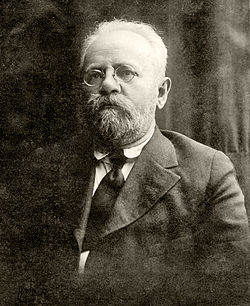Nachman Syrkin
Nachman Syrkin (born February 11, jul. / 23. February 1868 greg. In Mogilev , Russian empire ; † 6. September 1924 in New York ) was the founder and leader of the Socialist Zionism (such as inventor of the collective settlements) and journalist and author in Hebrew, Yiddish, Russian, German and English.
Life
In 1884 his family went to Minsk , and Syrkin attended the Russian high school there. He soon joined the Chovevei Zion and maintained contacts with Russian revolutionary circles, and was therefore imprisoned in 1888. After his release he went to London and Berlin , where he studied psychology and philosophy (PhD in philosophy in Bern in 1903 ). In Berlin, Syrkin had founded the Russian-Jewish Scientific Society , from whose midst the second generation of Zionist leaders grew: Schmarjahu Levin , Leo Motzkin , Chaim Weizmann and others.
At the first Zionist Congress he stood out as the leader of the socialist Zionists and supported the idea of the Jewish National Fund, which was first formulated by Hermann Schapira (on the occasion of the Katowice Conference in 1884 and again at the first Congress). At the Second Zionist Congress (August 1898, Basel ) he submitted a resolution for this. At the third congress (August 1899 Basel) he again presented his views on socialist Zionism, namely the assumption that the problem of the Jews of the diaspora would remain unsolved even after the socialist revolution. The only solution for Jewish existence is immigration and concentration on one territory.
Syrkin was banned from Germany in 1904, went to Paris and returned to Russia after the 1905 revolution to continue fighting for the idea of socialist Zionism. In 1907 he emigrated to America, joined the Poalei Zion movement and became involved again in the Zionist organization. Until his death he was the leader of the American Poalei Zion.
In 1919 Syrkin was part of the American Jewish delegation to the Versailles Peace Conference and also played a leading role in the Stockholm Poalei Zion meeting that same year.
His wish to go to Eretz Israel was no longer fulfilled. He died suddenly and unexpectedly of a heart attack. In 1951, twenty-seven years after his death, his remains were interred in Kibbutz Kinneret alongside the other Zionist leaders of the Jewish labor movement.
Marie Syrkin (1899–1989), author, Jewish educator, poet, journalist, editor and Zionist leader in America, close friend of Golda Meir , whose biography she wrote, was the daughter of Nachman Syrkin. She also published her father's memoirs.
Kfar Sirkin or: Kefar Syrkin (Hebrew: כפר סירקין) near Petach Tikwa is named after Nachman Syrkin (founded 1933).
position
Syrkin was a critical and independent spirit, the disputes with almost every Zionist direction as well as in their own camp - z. B. with Ber Borochov - had. He lived Jewish religiosity without contradicting his “worldly” goals and ideals.
Fonts (selection)
- Nachman Syrkin: historical-philosophical considerations . F. Gottheimer, Berlin 1896.
- Ben Elieser: The Jewish question and the socialist Jewish state . Steiger, Bern 1898 ( excerpts in English ).
- Nachman Syrkin: Sensation and Imagination (= Bern studies on philosophy and its history . No. 33 ). Scheitlin Spring & cie, Bern 1903.
- Ben Elieser: Essays on socialist Zionism . Young Poale Zion Alliance of America, New York 1935 (English).
- Nachman Syrkin, Marie Syrkin: Socialist Zionist; a biographical memoir and selected essays . Herzl Press, New York 1961 (English).
Web links
Individual evidence
- ^ A b Salomon Wininger : Great Jewish National Biography. Vol. VI, Tipografia ARTA, Czernowitz 1932, p. 72 f.
- ↑ a b jafi.jewish-life.de
| personal data | |
|---|---|
| SURNAME | Syrkin, Nachman |
| BRIEF DESCRIPTION | Founder and leader of socialist Zionism |
| DATE OF BIRTH | February 23, 1868 |
| PLACE OF BIRTH | Mahiljou , Russian Empire |
| DATE OF DEATH | September 6, 1924 |
| Place of death | New York City |

